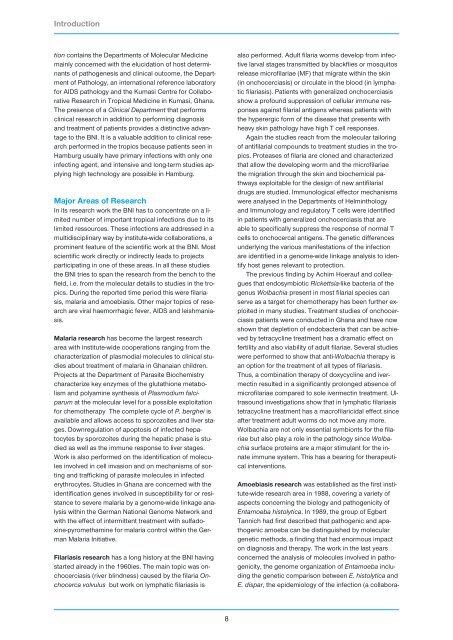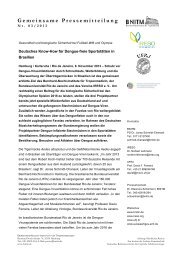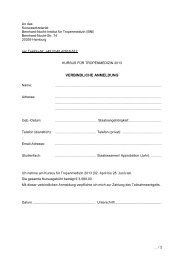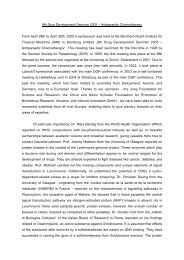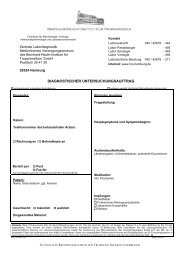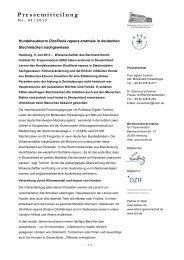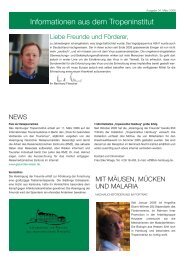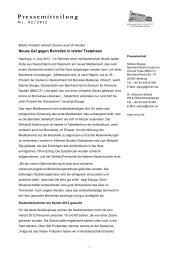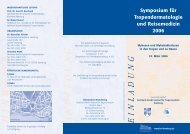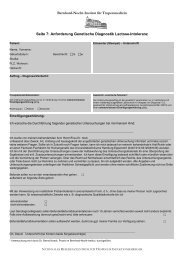Research Group Heussler (Malaria I) - Bernhard-Nocht-Institut für ...
Research Group Heussler (Malaria I) - Bernhard-Nocht-Institut für ...
Research Group Heussler (Malaria I) - Bernhard-Nocht-Institut für ...
You also want an ePaper? Increase the reach of your titles
YUMPU automatically turns print PDFs into web optimized ePapers that Google loves.
Introduction<br />
tion contains the Departments of Molecular Medicine<br />
mainly concerned with the elucidation of host determinants<br />
of pathogenesis and clinical outcome, the Department<br />
of Pathology, an international reference laboratory<br />
for AIDS pathology and the Kumasi Centre for Collaborative<br />
<strong>Research</strong> in Tropical Medicine in Kumasi, Ghana.<br />
The presence of a Clinical Department that performs<br />
clinical research in addition to performing diagnosis<br />
and treatment of patients provides a distinctive advantage<br />
to the BNI. It is a valuable addition to clinical research<br />
performed in the tropics because patients seen in<br />
Hamburg usually have primary infections with only one<br />
infecting agent, and intensive and long-term studies applying<br />
high technology are possible in Hamburg.<br />
Major Areas of <strong>Research</strong><br />
In its research work the BNI has to concentrate on a limited<br />
number of important tropical infections due to its<br />
limited ressources. These infections are addressed in a<br />
multidisciplinary way by institute-wide collaborations, a<br />
prominent feature of the scientific work at the BNI. Most<br />
scientific work directly or indirectly leads to projects<br />
participating in one of these areas. In all these studies<br />
the BNI tries to span the research from the bench to the<br />
field, i.e. from the molecular details to studies in the tropics.<br />
During the reported time period this were filariasis,<br />
malaria and amoebiasis. Other major topics of research<br />
are viral haemorrhagic fever, AIDS and leishmaniasis.<br />
<strong>Malaria</strong> research has become the largest research<br />
area with institute-wide cooperations ranging from the<br />
characterization of plasmodial molecules to clinical studies<br />
about treatment of malaria in Ghanaian children.<br />
Projects at the Department of Parasite Biochemistry<br />
characterize key enzymes of the glutathione metabolism<br />
and polyamine synthesis of Plasmodium falciparum<br />
at the molecular level for a possible exploitation<br />
for chemotherapy The complete cycle of P. berghei is<br />
available and allows access to sporozoites and liver stages.<br />
Downregulation of apoptosis of infected hepatocytes<br />
by sporozoites during the hepatic phase is studied<br />
as well as the immune response to liver stages.<br />
Work is also performed on the identification of molecules<br />
involved in cell invasion and on mechanisms of sorting<br />
and trafficking of parasite molecules in infected<br />
erythrocytes. Studies in Ghana are concerned with the<br />
identification genes involved in susceptibility for or resistance<br />
to severe malaria by a genome-wide linkage analysis<br />
within the German National Genome Network and<br />
with the effect of intermittent treatment with sulfadoxine-pyromethamine<br />
for malaria control within the German<br />
<strong>Malaria</strong> Initiative.<br />
Filariasis research has a long history at the BNI having<br />
started already in the 1960ies. The main topic was onchocerciasis<br />
(river blindness) caused by the filaria Onchocerca<br />
volvulus but work on lymphatic filariasis is<br />
8<br />
also performed. Adult filaria worms develop from infective<br />
larval stages transmitted by blackflies or mosquitos<br />
release microfilariae (MF) that migrate within the skin<br />
(in onchocerciasis) or circulate in the blood (in lymphatic<br />
filariasis). Patients with generalized onchocerciasis<br />
show a profound suppression of cellular immune responses<br />
against filarial antigens whereas patients with<br />
the hyperergic form of the disease that presents with<br />
heavy skin pathology have high T cell responses.<br />
Again the studies reach from the molecular tailoring<br />
of antifilarial compounds to treatment studies in the tropics.<br />
Proteases of filaria are cloned and characterized<br />
that allow the developing worm and the microfilariae<br />
the migration through the skin and biochemical pathways<br />
exploitable for the design of new antifilarial<br />
drugs are studied. Immunological effector mechanisms<br />
were analysed in the Departments of Helminthology<br />
and Immunology and regulatory T cells were identified<br />
in patients with generalized onchocerciasis that are<br />
able to specifically suppress the response of normal T<br />
cells to onchocercal antigens. The genetic differences<br />
underlying the various manifestations of the infection<br />
are identified in a genome-wide linkage analysis to identify<br />
host genes relevant to protection.<br />
The previous finding by Achim Hoerauf and colleagues<br />
that endosymbiotic Rickettsia-like bacteria of the<br />
genus Wolbachia present in most filarial species can<br />
serve as a target for chemotherapy has been further exploited<br />
in many studies. Treatment studies of onchocerciasis<br />
patients were conducted in Ghana and have now<br />
shown that depletion of endobacteria that can be achieved<br />
by tetracycline treatment has a dramatic effect on<br />
fertility and also viability of adult filariae. Several studies<br />
were performed to show that anti-Wolbachia therapy is<br />
an option for the treatment of all types of filariasis.<br />
Thus, a combination therapy of doxycycline and ivermectin<br />
resulted in a significantly prolonged absence of<br />
microfilariae compared to sole ivermectin treatment. Ultrasound<br />
investigations show that in lymphatic filariasis<br />
tetracycline treatment has a macrofilaricidal effect since<br />
after treatment adult worms do not move any more.<br />
Wolbachia are not only essential symbionts for the filariae<br />
but also play a role in the pathology since Wolbachia<br />
surface proteins are a major stimulant for the innate<br />
immune system. This has a bearing for therapeutical<br />
interventions.<br />
Amoebiasis research was established as the first institute-wide<br />
research area in 1988, covering a variety of<br />
aspects concerning the biology and pathogenicity of<br />
Entamoeba histolytica. In 1989, the group of Egbert<br />
Tannich had first described that pathogenic and apathogenic<br />
amoeba can be distinguished by molecular<br />
genetic methods, a finding that had enormous impact<br />
on diagnosis and therapy. The work in the last years<br />
concerned the analysis of molecules involved in pathogenicity,<br />
the genome organization of Entamoeba including<br />
the genetic comparison between E. histolytica and<br />
E. dispar, the epidemiology of the infection (a collabora-


